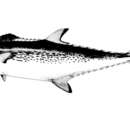Diagnostic Description
provided by Fishbase
Interpelvic process small and bifid. Body covered with small scales. Lateral line without auxiliary branches anteriorly, gradually curving down toward caudal peduncle. Intestine with 2 folds and 3 limbs. Juveniles have spots but develop adult pattern of interrupted lines by the time they reach 40 cm.
Migration
provided by Fishbase
Oceanodromous. Migrating within oceans typically between spawning and different feeding areas, as tunas do. Migrations should be cyclical and predictable and cover more than 100 km.
Morphology
provided by Fishbase
Dorsal spines (total): 15 - 17; Dorsal soft rays (total): 19 - 21; Analsoft rays: 19 - 22; Vertebrae: 45 - 46
Trophic Strategy
provided by Fishbase
Forms large schools which are often found in the Zanzibar Channel around March or April until August or September.
Biology
provided by Fishbase
Neritic species (Ref. 5313). Forms large schools in the Zanzibar Channel from March to September. Feeds mainly on anchovies (Anchoviella sp.), clupeids (Amblygaster sp., Sardinella fimbriata, Sardinella perforata [= Sardinella albella), other small fishes, squids, and mantis shrimps.
Importance
provided by Fishbase
fisheries: commercial; gamefish: yes
Kanadi kingfish
provided by wikipedia EN
The Kanadi kingfish (Scomberomorus plurilineatus) is a species of ray-finned bony fish in the family Scombridae, the mackerel family. Also known as the Kanadi seerfish, queen mackerel, or spotted mackerel, it is found in subtropical waters of the western Indian Ocean, Seychelles, Kenya and Zanzibar to South Africa and along the west coast of Madagascar. Kanadi kingfish commonly occur in depths of 50 to 200 m (164 to 656 ft). Specimens have been recorded at up to 120 cm (47 in) in length, and weighing up to 12.5 kg (28 lb). They feed mainly on small fishes such as anchovies and clupeids, squids, and mantis shrimps.[2]
References

- license
- cc-by-sa-3.0
- copyright
- Wikipedia authors and editors
Kanadi kingfish: Brief Summary
provided by wikipedia EN
The Kanadi kingfish (Scomberomorus plurilineatus) is a species of ray-finned bony fish in the family Scombridae, the mackerel family. Also known as the Kanadi seerfish, queen mackerel, or spotted mackerel, it is found in subtropical waters of the western Indian Ocean, Seychelles, Kenya and Zanzibar to South Africa and along the west coast of Madagascar. Kanadi kingfish commonly occur in depths of 50 to 200 m (164 to 656 ft). Specimens have been recorded at up to 120 cm (47 in) in length, and weighing up to 12.5 kg (28 lb). They feed mainly on small fishes such as anchovies and clupeids, squids, and mantis shrimps.
- license
- cc-by-sa-3.0
- copyright
- Wikipedia authors and editors
Description
provided by World Register of Marine Species
Forms large schools in Zanzibar Channel from March to September. Feeds mainly on anchovies (@Anchoviella@ sp.), clupeids (@Amblygaster@ sp., @Sardinella fimbriata@, @S. perforata@), other small fishes, squids, and mantis shrimps.
Froese, R. & D. Pauly (Editors). (2023). FishBase. World Wide Web electronic publication. version (02/2023).
- license
- cc-by-4.0
- copyright
- WoRMS Editorial Board

